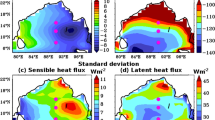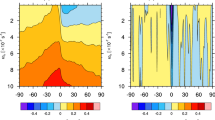Abstract
We estimated the northward heat flux through the eastern channel of the Bering Strait during the ice-free seasons between 1999 and 2008. This is likely about half of the total heat flux through the strait. The net volume transport and heat flux through the eastern channel of the strait were estimated from multiple linear regression models with in-situ/satellite remotely sensed datasets and NCEP reanalysis 10 m wind. The net volume transport was well explained by the west-east slope of sea level anomaly and NNW wind component at the strait. On the heat flux, the contributions of both barotropic and baroclinic components were taken into account. Estimated volume transport and vertical profile of temperature were used to calculate northward heat flux through the eastern channel of the strait. The magnitude of the estimated heat flux is comparable to estimates from in-situ measurements. Averaged heat flux in the eastern Bering Strait between 2004 and 2007 was about 1.9 times larger than that between 2000 and 2003. Maximum heat flux occurred in 2004, and same magnitude of heat flux was estimated from 2005 to 2007. This resulted not only from the increase in northward volume transport but also anomalous warm water intrusion from the Bering Sea. Our results suggest a candidate among the important parameters controlling heat budget, which contributes to the Arctic sea ice reduction, whereas more studies are required to confirm that this mechanism is actually responsible for the interannual and longer timescale variability.
Similar content being viewed by others
References
Aagaard, K., A. T. Roach and J. D. Schumacher (1985): On the wind-driven variability of the flow through Bering Strait. J. Geophys. Res., 90(C4), 7213–7221.
Benada, J. R. (1997): PO.DAAC Merged GDR (TOPEX/POSEIDON) Generation B User’ Handbook Version 22.0. JPL Rep. D-11007. Pasadena, California, 122 pp.
Cherniawsky, J., W. R. Crawford, O. Nikitin and E. C. Carmack (2005): Bering Strait transports from satellite altimetry. J. Mar. Res., 63(5), 887–900.
Clement, J. L., W. Maslowski, L. W. Cooper, J. M. Grebmeier and W. Walczowski (2005): Ocean circulation and exchanges through the northern Bering Sea-1979-2001. Deep-Sea Res. II, 52, 3509–3540.
Coachman, L. K. and K. Aagaard (1981): Re-evaluation of water transports in the vicinity of Bering Strait. p. 95–110. In The Eastern Bering Sea Shelf: Oceanography and Resources, Vol. 1, ed. by D. W. Hood and J. A. Calder, National Oceanic and Atmospheric Administration, Washington, D.C.
Coachman, L. K. and K. Aagaard (1988): Transport through Bering Strait: Annual and interannual variability. J. Geophys. Res., 93(C12), 15,535–15,539.
Coachman, L. K., K. Aagaard and R. B. Tripp (1975): Bering Strait: The Regional Physical Oceanography. University of Washington Press, Seattle, 172 pp.
Donlon, C. J. (2009): GHRSST-PP User Requirement Document version 1.7. The GHRSST-PP Project Office, p. 1–7.
Godin, G. (1972): The Analysis of Tides. Liverpool University Press, 263 pp.
Holland, M. M., C. M. Bitz and B. Tremblay (2006): Future abrupt reductions in the summer Arctic sea ice. Geophys. Res. Lett., 33, L23503, doi:10.1029/2006GL028024.
Hu, H. and J. Wang (2010): Modeling effects of tidal and wave mixing on circulation and thermohaline structures in the Bering Sea: Process studies. J. Geophys. Res., 115, C01006, doi:10.1029/2008JC005175.
Picot, N., K. Case, S. Desai and P. Vincent (2003): AVISO and PODAAC User Handbook. IGDR and GDR Jason Products, SMM-MU-M5-OP-13184-CN (AVISO), JPL D-21352 (PODAAC).
Rigor, I. G., J. M. Wallace and R. L. Colony (2002): Response of sea ice to the Arctic Oscillation. J. Climate, 15(18), 2648–2663.
Roach, A. T., K. Aagaard, C. H. Pease, S. A. Salo, T. Weingartner, V. Pavlov and M. Kulakov (1995): Direct measurements of transport and water properties through the Bering Strait. J. Geophys. Res., 100(C9), 18,443–18,457.
Shimada, K., E. C. Carmack, K. Hatakeyama and T. Takizawa (2001): Varieties of shallow temperature maximum waters in the western Canadian Basin of the Arctic Ocean. Geophys. Res. Lett., 28(18), 3441–3444.
Shimada, K., T. Kamoshida, M. Itoh, S. Nishino, E. Carmack, F. MacLaughlin, S. Zimmermann and A. Proshutinsky (2006): Pacific Ocean inflow: Influence on catastrophic reduction of sea ice cover in the Arctic Ocean. Geophys. Res. Lett., 33, L08605, doi:10.1029/2005GL025624.
Spaulding, M., T. Isaji, D. Mendelsohn and A. C. Turner (1987): Numerical simulation of wind-driven flow through the Bering Strait. J. Phys. Oceanogr., 17, 1799–1816.
Wang, J. and M. Ikeda (2000): Acrtic Oscillation and Arctic sea-ice oscillation. Geophys. Res. Lett., 27, 1287–1290.
Wang, J., H. Hu, K. Mizobata and S. Saitoh (2009a): Seasonal variations of sea ice and ocean circulation in the Bering Sea: A model-data fusion study. J. Geophys. Res., 114, C02011, doi:10.1029/2008JC004727.
Wang, J., J. Zhang, E. Watanabe, K. Mizobata, M. Ikeda, J. E. Walsh, X. Bai and B. Wu (2009b): Is the Dipole Anomaly a major driver to record lows in the Arctic sea ice extent? Geophys. Res. Lett., 36, L05706, doi:10.1029/2008GL036706.
Watanabe, E., J. Wang, A. Sumi and H. Hasumi (2006): Arctic dipole anomaly and its contribution to sea ice export from the Arctic Ocean in the 20th century. Geophys. Res. Lett., 33, L23703, doi:10.1029/2006GL028112.
Woodgate, R. A., K. Aagaard and T. J. Weingartner (2005a): Monthly temperature, salinity, and transport variability of the Bering Strait throughflow. Geophys. Res. Lett., 32, L04601, doi:10.1029/2004GL021880.
Woodgate, R. A., K. Aagaard and T. Weingartner (2005b): A year in the physical oceanography of the Chukchi Sea: Moored measurements from fall 1990–1991. Deep-Sea Res. II, 52, 3116–3149.
Woodgate, R. A., K. Aagaard and T. J. Weingartner (2006): Interannual changes in the Bering Strait fluxes of Volume, Heat and Freshwater between 1991 and 2004. Geophys. Res. Lett., L15609, doi:10.129/2006GL026931.
Wu, B., J. Wang and J. E. Walsh (2006): Dipole anomaly in the winter Arctic atmosphere and its association with sea ice motion. J. Climate, 19(2), 210–225.
Author information
Authors and Affiliations
Corresponding author
Additional information
An erratum to this article can be found at http://dx.doi.org/10.1007/s10872-010-0072-2
Rights and permissions
About this article
Cite this article
Mizobata, K., Shimada, K., Woodgate, R. et al. Estimation of heat flux through the eastern Bering Strait. J Oceanogr 66, 405–424 (2010). https://doi.org/10.1007/s10872-010-0035-7
Received:
Revised:
Accepted:
Published:
Issue Date:
DOI: https://doi.org/10.1007/s10872-010-0035-7




